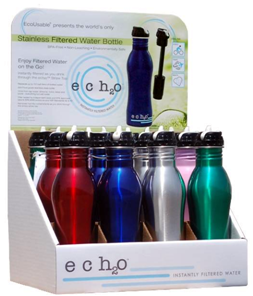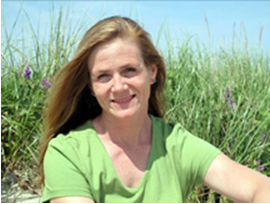
Quenching Our Thirst for
Bottled Water
by Katie O’Sullivan
Bottled water.
A generation ago it was almost unheard of, but today’s consumers spend billions of dollars on “designer” water in disposable plastic bottles. The evidence of this excess washes up on Cape Cod beaches every day.
According to studies, Americans throw away thirty billion plastic water bottles every year.
Most plastic bottles don’t get recycled and either spend 1,000 years decomposing in landfills or release chemicals into the air when incinerated. Huge garbage masses of “plastic stew” have been discovered in every ocean on the planet.
The manufacture of the petroleum plastic to make the bottles releases a variety of chemicals into the environment. The carbon footprint created by the transportation and distribution of those bottles, and the waste stream produced by the disposal of the bottles, need to be factored in to the ultimate cost to our planet.
Click here to watch Annie Leonard's powerful 8-minute documentary about the bottled water industry’s attacks on tap water.
Did you know that most of this expensive bottled water is actually filtered tap water?
When soda sales began to decline, beverage industry giants Coke and Pepsi jumped onto the bottled water bandwagon and now own 24% of the market, but both Coke’s Dasani and Pepsi’s Aquafina are just tap water.
If the tap water we use at home cost the same as bottled water, each of our monthly water bills would average $9,000.
We spend over $15 billion each year on bottled water. Per gallon, it’s exponentially more expensive than gasoline, yet no one thinks twice about plunking down a few dollars for 12 ounces of water.
Bottled water operations also take a natural resource out of the hands of local government and place it under corporate control.
The popular brand Fiji Water, for example, bottles more than a million bottles a day at the spring source on the island. At the same time, more than half of the people living on Fiji do not have reliable drinking water.
Several organizations have recently mounted campaigns to bring the facts about bottled water to the public’s attention, including the Sierra Club, Oceana, and Food and Water Watch.
The Water Front, Flow: For Love of Water, Liquid Assets, Blue Gold, and Tapped are five recent documentaries that highlight both the problems created by bottled water and the array of characters – from activists to corporate CEOs – currently struggling over this vital resource.
The movies show how communities from the U.S. to India are fighting to take public control of their water systems and defend their human right to safe, affordable and accessible water.
What can consumers do? The answer is simple: buy a reusable bottle and fill it with your own tap water.

The Beauty of the Reusable Bobble, available online www.waterbobble.com or locally at Red Fish Blue Fish in Hyannis www.redfishbluefish.com
U.S. tap water is often cleaner and safer than bottled water, as local water departments must meet the stricter Environmental Protection Agency regulations than the more lax standards set by the Food and Drug Administration for bottled water.
The question then becomes one of consumer choice: size, shape, color, price, plastic, aluminum, stainless steel, with or without a filter… the options seem endless. The most basic question is plastic or metal, but not all plastics are created equal.
The U.S Congress is currently considering a bill co-sponsored by Massachusetts Representative Edward J. Markey that would ban BPA from baby bottles, sports water bottles, reusable food containers, infant formula liners and food can liners.
Until BPA is banned, it’s important to check the numbers on your water bottles. Out of the seven classes of plastic used in food packaging, type 7 is the catch-all “other” class, and some type 7s are made with BPA. All type 3 plastics contain BPA. If your water bottle comes from a discount store and has no symbol on it at all, stop using it.
Of the plastic water bottles researched and tried here at the magazine, we recommend one of the newest entries to the marketplace: the Bobble. A stylish water bottle made in the U.S that filters water as you drink, Bobble’s carbon filter removes chlorine and contaminants from tap water.
“We set out to design a bottle that would improve the taste of tap water to the point where consumers could turn on their faucet, rather than open their wallet, says Richard Smiedt, founder of Move Collective, LLC, maker of the Bobble. “Our patented filtered water bottle achieves that goal.”
BPA-free and made from recycled plastic, the Bobble was designed by renowned industrial designer Karim Rashid and comes in six distinct colors: green, red, blue, magenta, black and yellow. Replacement filters can be purchased separately.
Jane Walsh, owner of Red Fish Blue Fish, first saw the Bobble online. “I am an anti-water bottle fanatic and banned my employees from bringing water bottles to work a long time ago,” says Jane. “I know from talking to people that most people have no idea of the environmental impacts, let alone the health impacts.”
She adds, “There have been studies showing that ingested plastics make their way into the bloodstream and cause various problems especially with the reproductive organs. Think about the rise in the use of plastics in our lifetimes and the rise of cancers in reproductive organs and problems with infertility.”
To avoid plastic altogether, consumers have a wide-variety of metal water bottles to choose from. Look for food-grade 18/8 stainless steel, as aluminum bottles and lesser quality metals have plastic liners that contain BPA. Good quality stainless steel bottles are going to cost more ($20-$40) but can last a lifetime.
Those unmarked metal bottles retailing for $2.99 at the discount store? Probably unlined aluminum, which studies have shown can contribute to Alzheimers.
 |
After research and our own road testing here at the magazine, we recommend the ECH20, a stainless steel filtered water bottle that debuted in 2009, made by EcoUsable, Inc.

The ECH20 is made of 18/8 stainless steel with no inner lining, thus is BPA free. The portable filtration system is ideal for turning tap water into high quality great tasting filtered water.
The company also claims the ECH20 allows users to drink from most lakes, streams and rivers in the USA as an emergency preparedness tool for campers or hikers. The average lifespan of a filter is about 6 months of regular use, and filter replacements can be purchased separately.
As a company, EcoUsable strives to be environmentally aware. They’re committed to helping eliminate single use plastics and find sustainable solutions that provide safe alternatives to plastic.
This past January, EcoUsable sponsored Pangaea Exploration’s ten-day sail to the North Atlantic trash gyre. The crew of the 72-foot Sea Dragon set sail from St. Thomas to Bermuda, researching the plastic pollution in the Atlantic Ocean. Their research can be found at www.5Gyres.org.
There are five known gyres in the world, where large systems of counter clockwise ocean currents trap floating plastic debris, swirling like huge toilet bowls.
Jane Walsh worries about the impact of these gyres. “I don't think too many people know about the trash island that’s the size of Texas in the Pacific, as well as the newly found one in the Atlantic,” she says. “Plastic is photo-degradable, so in the sun, in the water, it breaks down harming and killing wildlife who mistake it for food – or who eat it and survive, only to end up on our dinner plates.”
Food for thought indeed.
To learn more about the impact the bottled water industry is having on the environment Check out these helpful websites:
http://na.oceana.org
www.sierraclub.org/cac/water
www.foodandwaterwatch.org/water/bottled

Katie O'Sullivan is the Editor of this magazine. She lives in Harwich with her family
In addition to reporting and editing, she writes contemporary fiction. Her first suspense novel, Unfolding the Shadows, was released in 2009. Her second novel, Perfect Strangers, is due out this summer.
For more information, visit Katie at her website or her blog